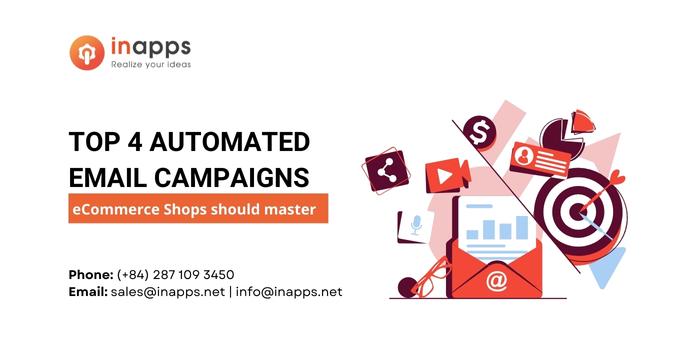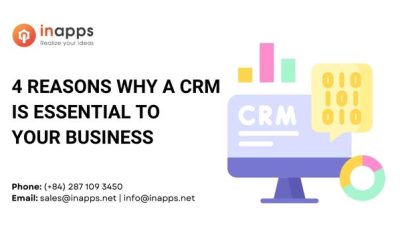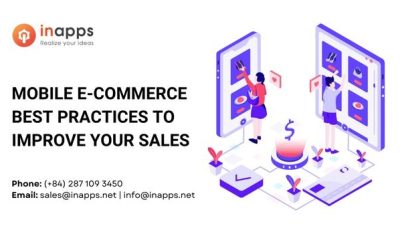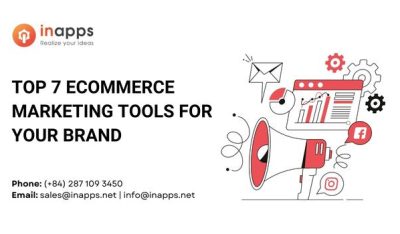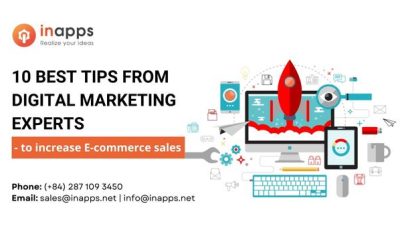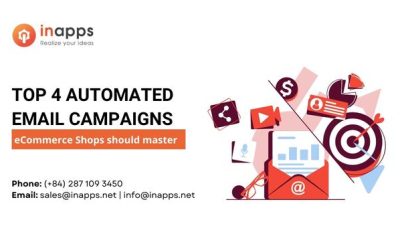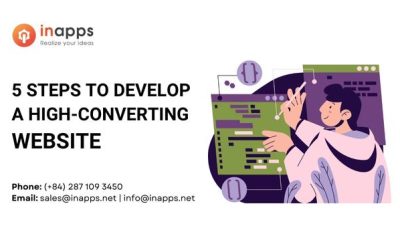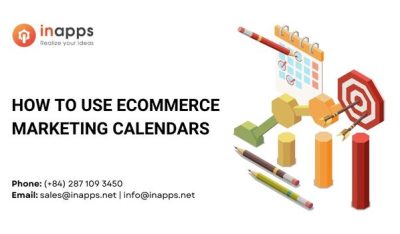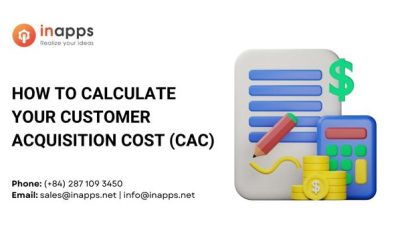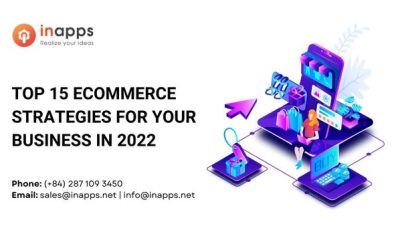- Home
- >
- Ecommerce Marketing
- >
- 4 Automated Email Campaigns eCommerce Shops Should Master
Four Automated Email Campaigns eCommerce Shops Should Master is an article sent to you by the InApps editorial team. Hope readers will have more useful knowledge at www.inapps.net
Imagine this: a new customer sees an eCommerce store’s ad online. They’re interested in style and fashion, and they love the images of the custom jewelry shown on their Instagram page.
Later that day, the prospective customer decides to visit their website to learn more about the brand and products, but they’re not ready to make a purchase just yet. Right before they leave, they see an exit popup, offering them a 10% discount on their first purchase if they enter their email address, and they subscribe.
Great, but what’s the next step for that business?
After adding a subscriber to an email list, a business’s next goal is to convert that subscriber into a paying customer, and then nurture that customer and convert them into a returning customer and brand advocate.
That’s where email marketing comes in, but we’re not just talking about one-time emails. One of the most effective ways to convert and retain customers is with relevant and useful automated email campaigns that reach your customer at just the right moment in their purchase cycle.
In this article, you’ll learn about four essential automated emails every eCommerce business should thoroughly understand and master. But first, let’s start with the basics.
What are automated email campaigns?
Automation tools and software help save time from performing time-consuming, repetitive, and unproductive tasks. Email marketing automation tools can help businesses send emails to potential and existing customers based on triggers defined in each campaign.
One type of trigger is to send emails at specific times. For instance, if a potential customer subscribes to your email list. You can set up an automated email campaign that automatically sends a welcome email exactly 1 day after they subscribed. With additional information about a customer. You can create automated email campaigns that are sent every year before a customer’s birthday or right before a scheduled subscription renewal.
Alternatively, marketers can use a subscriber’s behavior as a campaign trigger. As an example, a business can set up an automated email that gets sent every 90 days to subscribers who haven’t made a purchase in that period.
Just how effective are automated emails? Dozens of studies have found that email automation can save businesses time and money, and increase engagement. Take a look a just a few stats:
- According to data from the Epsilon Email Institute, automated emails had 76.7% higher open rates on average, and 151.9% higher click-through rates than other emails.
- Businesses who send automated emails are 133% more likely to send messages that accurately correspond with a customer’s purchase cycle, according to a Lenskold and Pedowitz.
- According to eMarketer, consumer-facing brands who connect with customers with automated emails see conversion rates as high as 50%.
Want to improve conversion and retention rates for your eCommerce business? Let’s walk through the four automated email campaigns every business should send to customers.
1. Welcome Email Campaigns
The first automated email campaign you need to set up is a welcome email, which should be trigged within the first few minutes of someone subscribing to your email list.
Welcome emails give new subscribers a better understanding of what to expect and how often they’ll receive emails. It’s also the perfect opportunity to offer subscribers helpful tips and tricks. A discount to encourage them to make their first purchase and it gives them information about how to get in touch with your business’ customer support team.
Welcome emails are also the chance for your business to make a positive first impression with a potential customer. In fact, data shows that 74% of people are expecting a welcome email once they subscribe, and subscribers who do receive them are 33% more likely to engage with a brand in the long term.
As an example, take a look at this welcome email from Birchbox, a monthly subscription box service.

After signing up for their subscription service, Birchbox explains to new customers exactly what they can expect from their service. Where they can go to find insider tips and tricks, and also encourages to visit their website to purchase their favorite items.
2. Order Confirmation Email Campaigns
Unlike brick-and-mortar stores, eCommerce customers must have blind faith that what they see on a website or app is exactly what they’ll receive at their doorstep. To earn the trust of a customer and build credibility as a legitimate eCommerce business, order confirmation emails are extremely important, especially since 64% of consumers consider transactional emails to be the most valuable type of emails they receive.
Order confirmation should also include the following critical information about a customer’s purchase:
- The order/transaction number and date of purchase.
- The name and quantity of the product(s) purchased. If available, information about the size, color, or product ID is also recommended.
- Payment summary and billing information.
- Shipping address and method.
- Estimated delivery date(s).
- Information about who or how to contact customer support.
Order confirmation emails also give businesses the ability to drive traffic back to their website and generate more revenue. For instance, a business can share a list of top-selling items or recommend products the customer may like based on their purchase. Businesses can also incentivize customers to return and make another purchase by offering a discount on their next purchase.

Equally important, confirmation email campaigns give businesses the ability to encourage customers to leave an online review. A study from the Pew Research Center found 82% of Americans say they consult online ratings and reviews when buying something for the first time.
3. Abandon Cart Email Campaign
According to Shopify, approximately 60-80% of online shopping carts are abandoned prior to a customer making a purchase. Realistically, it’s virtually impossible to convert every person who visits your site, but businesses can recover potentially lost sales with abandon cart email campaigns.
According to a report from SaleCycle, abandoned cart emails have an average 46.1% open rate, a 13.3% click rate, and $5.64 per email in extra revenue. Another study conducted by HubSpot also found that of the people who do return to their abandoned cart, 72% of them make a purchase within 24 hours of abandoning the product.

4. Sales Promotion Email Campaigns
Who doesn’t love a good deal? Think of the thrill a customer gets when opening an email, seeing the 15% discount code. But wait! It’s for a limited time only! So hurry now!
Give customers even more reasons to return to your store and make a purchase by sending out sales promotion email campaigns. The most common type of sales promotion email is to promote a flash sale, limited-time or seasonal offer, or instant discounts.
When sending these kinds of emails, make sure to tell recipients exactly what the deal is to help manage expectations. For instance, in Loft’s flash sale email below, they tell recipients the sale applies only to select full-price styles and the discount is only available on their online store.
Pro Tip: add copy that creates a sense of urgency or FOMO (fear of missing out). These psychological triggers are power purchase drivers, but whenever you promote a time-sensitive deal, make sure to include the time and date the promotion will end in the email.

Aside from discount codes and flash sales, here are a few other types of promotional emails to try:
- Free samples or giveaways: Looking to launch or want to raise awareness of new products, or re-engage inactive email subscribers, a promotional email that offers a free sample or giveaway is a useful tactic.
- Free shipping or delivery offers: Aside from a percentage discount or coupon, another effective way to incentivize existing customers to make a purchase is to offer free shipping or delivery on their next order. Pro Tip: Just like abandon cart email campaigns, free shipping or deliver offers can help businesses reactivate one-time customers who haven’t made a second purchase in a while, so use that opportunity to recommend new products the customer may be interested in.
What Consumers Do (and Don’t) Want In Emails From Brands
In 2018, consumers around the globe were sent and received nearly 281 billion emails each day, resulting in more and more consumers taking steps to block messages cluttering their inbox.
In Adobe’s 2018 Consumer Email Survey of U.S. consumers, 50% said that email is their preferred channel for being contacted by brands, but the survey also found 39% of consumers said they want brands’ marketing emails to be less promotional and more informational, and 27% said they want emails that are more tailored to their interests.
The survey also uncovered nearly half of respondents consider to be the most annoying thing about receiving marketing emails: they’re emailed too often. Another 22% of respondents said their pet peeve is receiving a promotional offer based on faulty data about the customer and another 22% said they’re aggravated by emails urging them to purchase a product or service they already bought.
It’s also important to be conscious of customers reading emails on their smartphones. Adobe’s survey found 65% of respondents use their smartphone as the primary device for checking emails. With that in mind, here are some Do’s and Don’ts to improve your business’ automated email campaigns.
DON’T: Go overboard on automated emails.
To ensure your emails are mobile-friendly, avoid lengthy and text-heavy emails that force customers to scroll too much and avoid using images, video, or animations that are hard to see or won’t load. Make sure the text in your email is easy to read and the email’s layout is compatible with multiple devices.
DO: Personalize automated emails
Use tools like merge tags and audience segmentation. Email automation tools make it easy to tailor emails based on basic customer information (i.e. name, location, etc.), purchase history, and email behavior. However, don’t use too much personalization—it could raise concerns about a customer’s privacy, resulting in distrust.
DON’T: Forget to A/B Test, Test, Test
Don’t just Google “what’s the best welcome email subject line?” Every eCommerce business’ audience is different and will react to different messaging. Therefore, use your email service provider’s automation tools to A/B test subject lines, images, discounts and offers, send times and frequency, CTA buttons, etc.
DO: Read up on GDPR rules
The General Data Protection Regulation (GDPR) is a data protection and privacy law designed to protect citizens of the European Union (EU). According to ZDNet, legislation requires organizations to ensure the personal data is collected legally and protected from misuse or exploitation. This applies to organizations operating within the EU. As well as non-EU organizations that provide goods and services to customers within the EU. Therefore, whether your business is based in the E.U. or not. Read up on the GDPR rules and proactively take steps to ensure your business is compliant.
And finally…
Don’t: Forget to read these helpful email marketing articles from InApps
For additional tips to help your eCommerce business improve its email marketing efforts. Check out these useful articles right here on our InApps blog:
If you have questions or comments, please leave them below. We’d love to hear your ideas.
Follow this to make sure you’ve got Four Automated Email Campaigns eCommerce Shops Should Master. Save and share with those around you these extras.
To learn more about Ecommerce Marketing
Contact us:
www.inapps.net
Let’s create the next big thing together!
Coming together is a beginning. Keeping together is progress. Working together is success.




